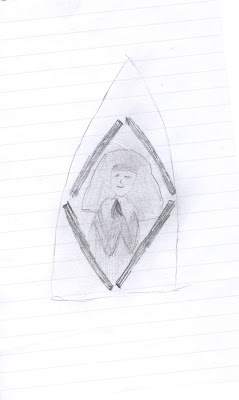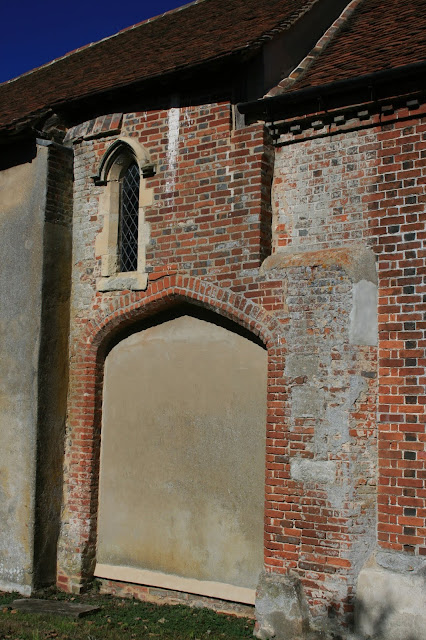Nōn potest
cīvitās abscondī suprā montem posita
On the surface, Greenwich Park is a welcoming, green, pleasant
space on the south bank of the River Thames, a place for Londoners to relax
over the weekend, the location of the Royal Observatory and the Prime Meridian.
For some, it’s a former Royal Hunting Park where King Henry
VIII and Queen Elizabeth I entertained their guests and, the place that saw
England launch its dominance of the waves from the Royal Naval College on its
North Western flank.
However, for a few, the area has a far deeper, hidden,
occult history that few suspect or can even dare to imagine.
A location where the pre-christian deities of Brigid,
Diana, Herne, Odin, the Snow Queen and the Dark Lady of the Fountain are said
to roam, if you have the desire to seek them out.
A place where you can find Saxon burial mounds, the
foundations of a Roman Temple dedicated to Diana, Goddess of the Moon, an oak
tree that good Queen Bess danced around and, a mysterious 19th
Century Drinking fountain known as The Motherstone, with a past that is only
just beginning to unravel.
Greenwich Park is all of these things, depending on the
person. What would we find there? What sort of person were we?
An invitation accepted
A good friend of ours, Sam, has a extensive working knowledge
of the Park, both from an historic and an esoteric perspective and has long suggested
that Laura may find a visit interesting so, with our respective schedules
finally coinciding, Laura and I decided to take him up on his longstanding
invitation and spend some time at the Park as his guest.
It was May, with the long period of hot weather for the
summer of 2018 that the UK would enjoy just beginning to kick in, so on a
particularly sunny morning we found ourselves crossing the QE2 Bridge into Kent
and driving into South London, where we had arranged to meet Sam, at the main
parking area at the southern end of the Park.
Making our way through the side streets to the Park,
driving along Vanbrugh Park (a road) and, up the slope at the junction with
Maze Hill, Laura turned to me and informed me that she was starting to feel her
stomach churning, along with a ‘pressure’, in her head.
It had begun.
Greenwich Park
Spotting the entrance to the Park on our right, we drove
in through Blackheath Gate and parked up. Within minutes Sam appeared, right on
cue, striding through the trees in the near distance, towards us.
Wasting no time, we gathered our camera and recording
equipment and left the car to greet Sam.
Almost immediately, Laura picked up upon a young girl,
about ten years of age, wearing a cream dress, possibly a night dress. Unfortunately,
she was unable to get a name.
Laura later told me, during the drive home, that her
first thoughts at this point were what had Sam brought with him?
After exchanging pleasantries, we decided to explore the
Park in a clockwise direction, heading towards the old Royal Naval College to
the North West, where it bordered the Thames, before returning back to where we
were now. Sounding like a plan, off we went, Sam leading the way.
Striding purposely along the west flank of the Park, near
the tennis courts, heading towards the remains of some Saxon burial mounds Laura
became aware of a quiet, male voice, as we walked between two trees, ‘I’m here’
the voice whispered. Laura drew my attention to what had just happened.
Looking quickly around, the nearest person to us appeared
to be around two hundred yards away, using a loud chainsaw. An unlikely
candidate we thought.
Later that evening, we carefully checked the audio recording
we made but, disappointingly, nothing was to be heard.
Moving on, Laura turned to Sam and asked him if there was
a Remembrance Garden? He replied that he wasn’t sure, but knew that there were a
number of benches with dedication plaques in the Park.
Soon after this brief conversation, we later found that we’d
recorded a faint EVP, our only one that we’d captured during our visit.
However, it was indistinct and we were unable to understand what was being
said, even following subtle enhancement of the capture and peer review.
The Large Standing Figure........
Passing through the Saxon burial mounds, Laura and I
spotted a sculpture on the opposite side of the plateau.
 |
| Large Standing Figure - attempting to blend into the background |
This was the 1976 Henry Moore sculpture - Large Standing
Figure: Knife Edge (LH 482a), one of the artists own copies, which has been on
display at Greenwich Park, for the second time, since 2011.
As we got closer, we heard a peel of bells in the
distance. Laura turned to Sam and asked him where the bells were coming from?
Sam told her that they were from the Royal Naval College,
rather than some nearby church, which we could at the bottom of the slope next
to the Thames, in the distance.
At this point I took some time to take some photographs,
leaving Sam and Laura to discuss further.
Continuing our journey, Laura advised that she’d picked
up the name ‘Blake’, a surname, near the statue.
Laura commented that the area had an unusual stillness,
taking into account how close it was to central London.
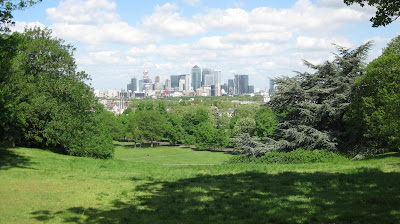 |
| The view towards Canary Warf |
Out of the blue, whilst we walking down the slope towards
the Naval College, Laura asked if there was ‘something’ about one of the trees
here, in the Park - she kept feeling that she should be looking for a tree and,
that she should go there to ‘get it done’.
Sam advised that he could think of possibly two trees, one
alive, one wasn’t, that could be possible candidates and, the general consensus
was that we should make our way to them.
Laura had also been given the name ‘Colonel Jacobs’,
advising she’d also got ‘orphanage’.
Unfortunately, she wasn’t sure if it was in the same
context as ‘Colonel Jacobs’.
We soon found ourselves approaching a cross roads on the
path, where the path we were walking along met Lover’s Walk. At the cross roads,
Laura turned and advised that she got ‘Sammy’, which was a boy, not a kid
(toddler), along with the name ‘Fellows’.
She felt that this surname could be connected to ‘Sammy’.
Echoes of War
In the shadow of the Royal Observatory, towering over us high
to our right, Laura got the impression of ‘aircraft’ and ‘645’ – although she
was not sure whether this was the time i.e. 06:45, or a number.
I asked if this was aircraft generally, or a specific
type? Laura replied, rather helpfully, that she wasn’t sure.
She went on to state that the aircraft was ‘taken down,
not crashed’ but was at pains to impress that this had to be made clear – taken
down, not crashed.
This was very important.
We paused, but nothing else was forthcoming so,
reluctantly, we moved on.
Little did we suspect that this snippet of information
would link significantly with what was discovered later on our tour.
The late Queen Elizabeth’s Oak
As we continued along the path, Laura got the name
‘Greives’. She knew that this not spelt conventionally, but this was how it was
given to her.
Laura then went on to inform Sam and I that she kept
picking up American (U.S.A.) connections, such as Columbus and California.
Sam advised that there could potentially be a Columbus
link at this location. Laura and I didn’t press him for this information, in
case it prejudiced anything else that Laura discovered.
We eventually found ourselves at Queen Elizabeth’s Oak,
one of the trees Sam suspected that Laura could have been referring to earlier.
Looking at the Oak’s decomposing state, lying on it’s
side, behind a low fence, Laura and I obviously suspected that this was the
dead tree that Sam had previously mentioned, without him having to say
anything.
 |
| Queen Elizabeth's Oak - lying in State |
Having came to the end of it’s life sometime during the
19th Century, it finally toppled over in a storm in 1991, when much
of the supporting soil was washed away.
Dating back to the 12th Century, it was named
after Elizabeth I, who was believed to have taken refreshments under the shade
of its boughs.
Legend has it that Henry VIII had danced with Anne Boleyn
around the tree prior to this.
However, in spite of the late tree’s incredible history,
Laura was of the opinion that this was not the tree that she needed to find.
Disappointed, we decided to move on and Sam guided us to
the feature known as ‘The Motherstone’ nearby.
However, as we walked away, Laura commented that she had
just been given the word ‘Carnean’, but she wasn’t sure if this was a name, a
place or even if it was a genuine word.
I was later able to establish that ‘Carnean’ was Spanish
for pull the wool over someone’s eyes. Was someone referring to an historic
event that took place at the tree, or perhaps something that was being
concealed from us, right here, right now?
The Motherstone
We soon reached a junction in the path and Sam steered us
left, following the path down a slope for a couple of paces, where we
immediately spotted the Motherstone, again to our left, partially obscured by
the low hanging branches of a nearby tree.
Facing us was what could only be described as two stone oblong
boulders, laying lengthways, one on top of the other, with a water bowl in the centre,
where the two stones met.
 |
| The 'Motherstone' |
The Motherstone, a former drinking fountain, was thought
to have been constructed between 1855 and 1863, to replace a wooden building
nearby that was being used to sell refreshments until it was demolished in 1855.
The Motherstone was first referenced in 1863, providing
an eight year window for its construction.
The water bowl originally drew water from a nearby spring,
which you could enjoy by means of two metal cups chained to the bowl. However,
the spring was capped in the mid 1950’s due to concerns over the water quality
and the Motherstone’s function as a fountain has been redundant ever since.
Although the Motherstone was of Victorian construction,
the stones appeared to have had a far older origin and it is now believed that
they originated from the Bluebell Hill area of Kent.
Whilst we were examining the stones, Laura complained
that she felt nauseous, very strongly, so we moved away from the vicinity of the
Motherstone with the hope that this would alleviate the situation for Laura.
Jack Gale, in his 1996 book Goddesses, Guardians &
Groves, The Awakening Spirit of the Land, states that many love the place (the
Motherstone), a few “find the place
threatening and intimidating, not wishing to remain there any length of time”
(p.45).
Laura, it would appear, clearly fell into the latter category.
Laura, it would appear, clearly fell into the latter category.
Regaining her composure, Laura reflected on her time at
the former springhead, but the overwhelming memory of the location for her was
that the area made her feel really sick.
Expanding further upon her experience, Laura told us that
she’d felt a hard pressure in her neck and her throat (indicating up against
her jaw on her right hand side) and then the nausea feeling almost immediately started.
Allowing Laura some time to lose the effects she had
experienced from the Motherstone, we left the path and cut across the grass to
a shady area with a number of trees dotted here and there, either side of a
gully.
As we approached the first of the trees, Laura commented
that her right arm had ‘gone really tight‘ and had tensed up.
Straight away, this was followed with Laura advising that
something wrong with her hands, both hands, at this particular location of the
Park.
Sam interjected and stated that this is close to a tree, the
second tree that he wished to show us.
Laura responded by telling him that her hands felt as if
they’d been “really burned” – raw, “proper burnt”.
We’d now been walking for about an hour, so we decided to
spend some time at the tree that Sam had indicated.
 |
| Laura at 'the tree' - what would it reveal, if anything? |
However, after ten minutes or so, it seemed that nothing
was forthcoming (from Laura's perspective) so, with reluctance, we decided to
move on.
However, Laura later revealed, as were leaving the Park, that
when she was examining the tree, she’d been given the name ‘Augustine’.
Maze Hill
As we walked across the grassed area surrounding the Maze
Hill Gate, the conversation turned to the history of the Park, as a Royal Park
and, some trees displaying signs of lightning strikes.
At this point, Laura was given the name ‘Jane Austen’, which
we obviously assumed referred to the well known 18th Century
novelist, but nothing else was picked up by Laura to confirm this assumption.
Laura then asked Sam if all the roads around here,
referring to the ones surrounding the Park, not those in the Park itself, were
through roads or, was one of them a dead end?
A discussion ensued amongst the three of us, with Laura throwing
in that it may have been a through road that was now blocked off.
Laura continued to expand, commenting that when we’d left
the tree and was walking past a patch of nettles, she’d been given the phrase
‘road to nowhere’ and had just got given the phrase again now.
I raised the possibility that the phrase could be
referring to something metaphorically, whilst Laura thought that it may not be
in the park, but somewhere not far away, but ‘around’.
Laura asked if the Park was divided out into more than
four sections?
Unbeknown to both Sam and myself at the time, this question
was asked in reference to her ‘Quadrant’ information that we shall discuss
later.
Sam confirmed that it was and, from above, it looked laid
out to a defined plan.
I then walked away from Laura and Sam to see if I could
make sense of what Laura had picked up.
I soon sighted an avenue of trees that wasn’t easily
spotted from where we were originally stood, so perhaps this was the solution?
The avenue was within the Park, but interestingly,
appeared to start and end between the two points that Laura had indicated. I
didn’t mention what I’d found to the others.
 |
| The Avenue? |
As we were close to where Laura had experienced the
churning sensation in her stomach as we originally approached in the car, we
decided to leave the Park and visited what we later found out was the Vanbrugh
Pits at Blackheath (East), adjacent to the Park.
Upon approaching the Heath, Laura confirmed to me the
churning in her stomach had returned.
Vanbrugh Pits is an area of old gravel workings, dating
from the late 18th Century, which was used to house a barrage
balloon during World War II. The area was named after Sir John Vanbrugh, the
architect of Blenheim Palace and Castle Howard, who had a house nearby.
We duly explored the grassland but, to our
disappointment, Laura was unable to establish anything that would have
explained the stomach churning sensation she was experiencing, even now, whilst
in the area.
With nothing else occurring, we decided to re-enter the
Park, near to where the Deer Park was located.
Walking back towards our original starting point on the
west side of the Park, having completed our circuit, Sam asked us if we had
time to visit another location that he would like to show us nearby.
With plenty of time to spare, we thought why not, so we
gave Sam the affirmative and once again left the confines of Greenwich Park.
Crown Point
As we made our way across the heath, Sam told us we were
heading to The Point, or more correctly Crown Point, to the west of the Park.
The Point is a popular viewing area, offering a fine vista
of the City of London and beyond including, on clear days, the Wembley Stadium
Arch, to the North West.
 |
| The view from the Point |
Upon entering the grassed area of The Point, the
quietness of the location was noticeable, in spite of the passing traffic.
Continuing our walk, I spotted a memorial stone set
against the barrier making the end of The Point, which Laura and I soon discovered
was for a fallen WWII pilot.
Reading the inscription, I pointed out to Laura and Sam
that the middle name of the pilot named on the memorial stone, ‘Richard Carew
Reynell’, was possibly similar to ‘Carnean’, the word Laura had picked up
earlier, as we were approaching the Motherstone.
Laura, to my dismay, strongly disagreed with this
suggestion.
She continued that, as we first entered ‘The Point’, she
picked up a name, ‘Ray’ and thought that it was Sam’s step-father (Sam
confirmed that it wasn’t), but it was quickly confirmed to her that it wasn’t
‘Ray’, but the first part of a word or name.
Although she tried, Laura was unable to get the rest of
the name, so she never said anything at the time.
Did Laura start to pick up the airman?
Who was Richard Carew Reynell?
The memorial confirmed that he had been killed nearby,
but where and how?
Another area of further research beckoned.
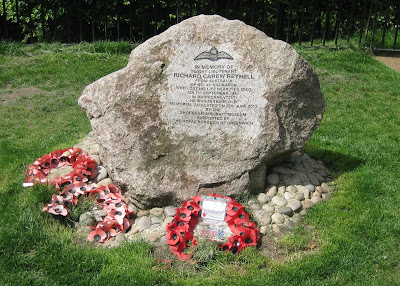 |
| The memorial to Flt Lt Richard Reynell |
As we walked back across The Point, back towards the
Park, I commented that it was strange as to why no houses had been built on the
land, taking into account the views of the City it offered and it’s close
proximity to it.
Sam advised that this was more likely due to what was
beneath The Point - chalk caverns.
Laura smiled and commented that she was going to ask if
there was a cave beneath the land.
He went on to explain both the geology and history of the
caverns, mentioning carvings and stated that he’d always felt that there was
energy ‘swirling’ here, like a whirlpool.
Laura felt that the area would take on a different
atmosphere at night, with Sam agreeing, confirming that some years ago, he had
visited at night along with a colleague and undertaken a meditation session,
with interesting results.
Our time drawing to a close, we made our way back to the
car, only stopping to examine a water conduit on the way, en route to the Cafe
in the Park, to enjoy some refreshments before we headed back to East Anglia.
Bidding Sam farewell, until the next time, we got back
into the car, to retrace our journey back home.
The final piece of the jigsaw?
As we drove away from the Park, Laura turned to me and
commented that, whilst we were walking around the Park itself, she was
continually being given the word ‘Quadrant’, right from the point that we
initially left the car.
I asked her why she didn’t raise this at the time, to which she replied that, as this was only the second time she’d met Sam in person, she didn’t want to come across as ‘strange’ to him.
I asked her why she didn’t raise this at the time, to which she replied that, as this was only the second time she’d met Sam in person, she didn’t want to come across as ‘strange’ to him.
During the drive home, we continued to discuss ‘Quadrant’
and both leant towards it referring to the layout of the Park, it clearly
having been landscaped in the past.
How wrong did this turn out to be, as our subsequent
research was to inform us.
Aftermath
At the time, whilst we enjoyed immensely our tour of
Greenwich Park and the surrounding area greatly, from Laura’s perspective, it
didn’t appear that active, when compared to other historic locations that we’d
visited in the past, although we both thought that a further visit would be
worthwhile.
However, upon reviewing our notes and, the audio
recording I made of our visit, it indicated that nothing could be further from
the truth – the challenge would be to establish the best way to go about it.
Our review provided a couple of areas where we should
focus our initial research, namely:
1. The
girl at Blackheath Gate
2. Colonel
Jacobs / Greives / Blake / Sammy Fellows
3. Jane
Austen
4. Richard
Carew Reynell
5. Quadrant
6. Augustine
Findings
Our research remains ongoing, but in the interest of
providing a baseboard for future field investigation, a summary of where our
research currently sits would be useful, we can therefore provide an overview
as follows:
1.
The young
girl in the cream dress at Blackheath Gate
Frustratingly, whilst we’ve
consulted many, many books and periodicals over the ensuing months, along with
the obligatory internet searches, our researches have drawn a blank so far.
We are unable to trace any
reference or indeed a tradition, of the ghost of a young girl at the Gate, nor
any other paranormal occurrence.
Unless anyone could inform us otherwise?
Unless anyone could inform us otherwise?
2.
Colonel
Jacobs / Greives / Blake
For convenience, we shall
cover these people in the same section. With what appears to be just a surname
to work with, these names will have to remain on our file, unless any
additional information comes to light.
Colonel Jacobs – The rank of Colonel has been used in the British
Army since the late 17th Century, as well as the armed forces of
other Countries. With a relatively common surname as Jacobs, we have traced a
number on individuals to date, although none having any ties, we have been able
to find, to the Greenwich area.
Greives – Nothing of any note found.
Blake – Possibly a reference to William Blake, the 18th
Century Artist and Poet, who was the artist of an engraving for the proposed
230 foot statue of Britannia atop of Greenwich Hill, in 1799; or
Admiral Robert Blake, a
national hero, whose successes have never been excelled, “not even by Admiral
Nelson himself”, according to one biographer. Whilst obviously having a link to
Greenwich by virtue of his profession, he lay in state at the Queen’s House at
Greenwich following his death in 1657, prior to a state funeral and burial at
Westminster Abbey.
As Laura had been given the name
‘Blake’ near to Henry Moore’s statue, did it point to William as being the Blake
that we should be focusing upon?
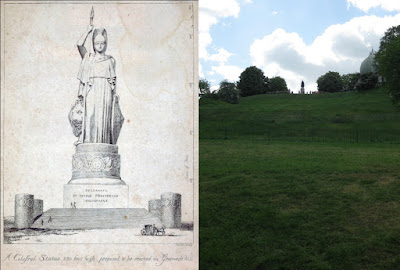 |
| William Blake's proposed 230ft Britannia Statue and, the eventual occupant of it's spot the life sized statue of Gen. James Wolfe |
Sammy Fellows – Nothing of any note has been found.
3. Jane
Austen
At first mention, Austen’s
name raised a smile amongst us – She was internationally known, widely acknowledged
as one of the greatest writers in the English language, with works such as
Emma, Sense and Sensibility and Pride and Prejudice to her credit, but why was
Laura given her name at Greenwich Park, of all places?
Had someone read one of her
novels, whilst laid on the grass one sunny afternoon or some other mundane
reason?
However, scratching the surface,
we were able to find a link to her and Greenwich Park.
Two of Austen’s brothers were Navel Officers – Admiral of the Fleet, Sir Francis Austen and, Rear Admiral Charles Austen, both of whom spent time at Greenwich and, it is known that she had spent time there visiting them (1).
Two of Austen’s brothers were Navel Officers – Admiral of the Fleet, Sir Francis Austen and, Rear Admiral Charles Austen, both of whom spent time at Greenwich and, it is known that she had spent time there visiting them (1).
In addition, she was friends
with Mary Pearson, eldest daughter of Capt. Sir Richard Pearson, who was the
Lt. Governor of the Greenwich Hospital for Seaman, the precursor for the Royal
Naval College.
In isolation, we cannot extent
our research any further than this, other that there was a connection, so her
appearance wasn’t as random as we first thought, so another visit to the Park
may be required to see if Laura is able to uncover any further information here.
(1) Letter to Cassandra Austen – 18th September 1796
4.
Flight
Lieutenant Richard Carew Reynell
Information relating to
Richard ‘Dick / Dickie’ Reynell was not hard to trace, with a couple of
reliable sources found after a quick search online, documenting the sad events
relating to the death of Reynell, which occurred on a sunny, Sunday afternoon, on
the first day of the London Blitz.
Flt Lt Reynell was an Australian
who had initially came to Britain in 1929 to study at Oxford University and
subsequently joined the RAF in 1931, where he served at No. 43 Squadron, which
was based at the time, at RAF Tangmere, near Chichester, in West Sussex.
His talent for flying saw him attached
to Hawker Aircraft Company as a test pilot, in 1937, where he was involved with
the development of the new Hawker Hurricane single seater fighter aircraft.
In August 1940, he returned to
No. 43 Squadron so he could evaluate the Hurricane’s performance under combat
conditions, which enabled him to make recommendations or modifications to improve
the aircraft.
He was due to return to Hawker
on the 7th September 1940 but opted to stay with the Squadron until
evening, so that he could take part in the day’s flying.
It was a decision that, sadly,
would cost him his life.
The morning started relatively
quietly, with a handful of bombs falling on London and the surrounds, but
little else.
However, as history subsequently
shows, things were about to change and little did Britain know that it was soon
to face the full might of the German Luftwaffe later that afternoon.
The German attack was in
response to a raid on Berlin two weeks earlier, with Hitler declaring to wipe
Britain’s Cities off the map and the afternoon of the 7th September,
in the middle of The Battle of Britain, saw the commencement of what we now
refer to as the London Blitz.
As the Luftwaffe flew across
the English Channel towards their targets, six planes from 43 Squadron was
scrambled at 4:30pm, with Reynell leading a half squadron of six, which was one
of the first two squadrons to greet the 170 or so advancing German planes over
Beachy Head, on the East Sussex Coast.
He and his Squadron pursued
the enemy to the Suburbs of South London, where Reynell finally engaged a Messerschmitt
Bf 109, over the skies of Blackheath.
During the engagement Reynell’s Hurricane was blown into three pieces, the engine falling through the roof of St Ursula’s Convent, opposite the Park’s western flank, causing a fire, whilst the main part of the fighter plane crashed to the ground onto Crown Point itself, where the monument to Reynell now stands.
During the engagement Reynell’s Hurricane was blown into three pieces, the engine falling through the roof of St Ursula’s Convent, opposite the Park’s western flank, causing a fire, whilst the main part of the fighter plane crashed to the ground onto Crown Point itself, where the monument to Reynell now stands.
Reynell himself was blown out
of the aircraft, falling rapidly, his parachute only being partially deployed,
crashing through a garden bench before he came to rest on the ground, at 3
Kidbrooke Grove, to the east of the Park.
Already in a bad way with
chest injuries, Reynell sadly passed away at the scene, before medical help could
arrive.
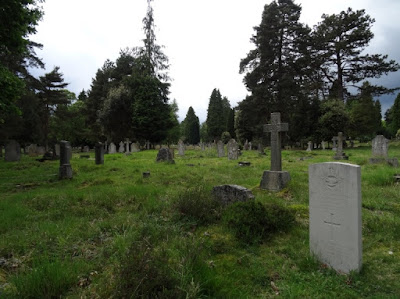 |
| Flt Lt Richard Reynell's Grave, at Brookwood Cemetery, Surrey |
Laura picked up four pieces of
information that she ascribed to Reynell, before we come across his monument:
i.
this involved an aircraft, albeit type unknown
ii.
the number 645
iii.
that this aircraft was taken down, not crashed;
and
iv.
the first part of a name – Ray
Considering the information in
relation to what I learnt surrounding Reynell on the 7th September
1940, the first piece of information is self explanatory, we were looking for
an incident involving an aircraft of some kind.
The second piece, the number
645, currently remains an enigma, it doesn’t relate to the place number or
Reynell’s service number and, not the time of the incident, which was recorded at
approximately 5pm. Could this relate to the time of his death? For the moment,
we feel not as, although we currently do not have the time that Reynell passed
away, only that it was before medical help could arrive, we feel that even in
such a time of emergency, 1 hour 45 minutes was too long a wait before medical
assistance arrived on the scene.
The third piece of information, that the aircraft didn’t crash but was taken down we found interesting. Reynell’s aircraft disintegrated in mid-air, with Reynell being thrown clear of his aircraft as it did so.
The third piece of information, that the aircraft didn’t crash but was taken down we found interesting. Reynell’s aircraft disintegrated in mid-air, with Reynell being thrown clear of his aircraft as it did so.
It was this, along with the
fourth piece of information, the first part of the name being ‘Ray’ that gave
us the belief that Laura was sensing this tragic incident, almost 78 years
after the event.
Sources (including online):
The Advertiser (Adelaide)
P7. 10th October 1938
P6. 19th December 1940
P9. 3rd September 1941
P17. 19th September
1941
P7. 16th November 1941
Blitzwalkers:
https://blitzwalkers.blogspot.com/2012/02/flight-lieutenant-richard-carew-reynell.html
https://blitzwalkers.blogspot.com/2013/06/the-fighting-cocks-black-saturday-and.html
5.
Quadrant
Due to our ignorance in
relation to the Park and the Observatory, our conversation during the drive home
focused upon the geometry of the Park, the way ornamental gardens had been laid
over the years.
We were firmly of the mind at
this point that quadrant related to how the Park was set out.
As we previously mentioned, how
wrong could we be on this point.
It didn’t take long for us to
discover that the term quadrant could also relate to an instrument used to
measure angles or, more relevant to Greenwich itself, longitude, latitude and
even time itself.
These instruments have been in
use for over 2,000 years, in some shape or form, having first being described
by Ptolemy in 150 AD.
Greenwich Park had been the
location for a Mural Quadrant (a large Quadrant attached to a wall) since
around 1676, the first being designed by Robert Hooke, the architect, natural
philosopher and polymath.
 |
| Robert Hook's original 1676 Mural Quadrant at Greenwich |
This was replaced by a
‘slight’ Mural Arc in 1683 and again in
1689, both quadrants by the Royal Astronomer John Flamsteed.
The final quadrant, another
Mural Arc, was erected in 1721 by Flamsteed’s successor, Edmund Halley (of comet
fame), which is now on display at the Meridian Building at the Royal
Observatory, albeit with several parts missing.
Unfortunately, whilst we were able to get to the source of Laura’s ‘quadrant’, she was unable to obtain any additional information relating to this during her visit, so our researches cannot progress any further at this point.
Unfortunately, whilst we were able to get to the source of Laura’s ‘quadrant’, she was unable to obtain any additional information relating to this during her visit, so our researches cannot progress any further at this point.
However, there was also a
possible connection with Robert Hooke elsewhere for Laura, which is something
that we’ll explore sometime in the future.
We know where the quadrants
were located and, where the final, only surviving one is now situated. Again, a
further visit will be necessary at some point, to attempt to progress this
aspect further.
6.
Augustine
Augustine of Canterbury (not to be confused with St Augustine of Hippo), born in Italy, was a Benedictine who became the first Archbishop of Canterbury on 597, being buried (originally) in what is now St Augustine’s Abbey in Canterbury.
Augustine of Canterbury (not to be confused with St Augustine of Hippo), born in Italy, was a Benedictine who became the first Archbishop of Canterbury on 597, being buried (originally) in what is now St Augustine’s Abbey in Canterbury.
We have not been able to find
any direct link between Augustine and Greenwich in our researches but noted
that the original route of Watling Street, upon which Canterbury lies, passes
through the north east corner of Greenwich Park, close to the Roman Temple (and
Motherstone) and to the place where Laura was given the name.
Although pure conjecture on
our part, did Laura pick up the thoughts of a traveller or clergyman from
Canterbury, passing through the Park, on their way into London?
Summary
Although we’ve yet to return, the Park remains a location
of great interest to us.
During our time there Sam was careful not to relate any
of the knowledge that he had of the area, unless directly asked, or steer us to
any particular location of interest (to himself), whilst he was there.
Perhaps this visit was only the start of our connection
to the Park. As with Greenwich itself, only time will tell.
Bibliography
A History of Greenwich – Beryl Platts (1973)
Working the Path – Jack Gale (1994)
Goddesses, Guardians & Groves – Jack Gale (1996)
Greenwich and Blackheath Past – Felix Barker (1999)









